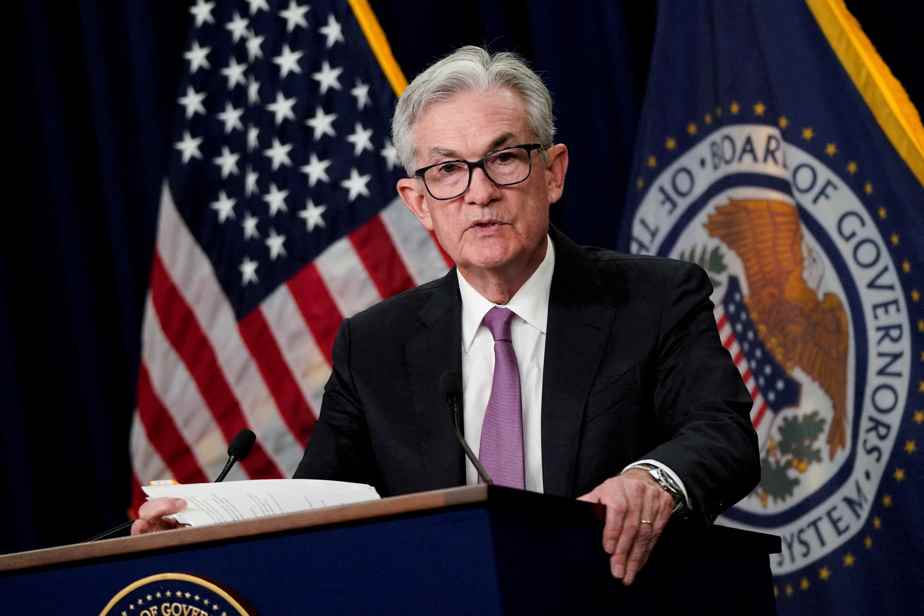(Washington) The fight against inflation in the United States “will hurt American households and businesses”, but giving up on it would be even more damaging for the economy, warned Friday the head of the central bank (Fed), Jerome Powell.
Posted at 10:05 a.m.
Updated at 5:54 p.m.
In a remark of a rare frankness, pronounced at the conference of the central bankers of Jackson Hole (Wyoming), the president of the Fed warned that the American Central Bank would use “vigorously its tools” by raising the interest rates.
Returning to price stability “will take time” and will lead to “a long period of lower growth” as well as “a slowdown in the labor market”, he said, a few months before the midterm elections. for the Democratic administration of Joe Biden.
Inflation in the United States was prancing to 8.5% in July year on year, against 9.1% in June, a 40-year high, according to the CPI consumer price index. According to another indicator closely observed by the Fed, the PCE index, published on Friday, it fell to 6.3% over one year in July, against 6.8% in June.
President Joe Biden welcomed this monthly decline in inflation, ensuring that Americans were beginning to experience “relief”, thanks to “gasoline prices which have fallen every day this summer”, in a press release. But “we still have work to do,” he added.
For Mr. Powell, “while these latest declines in July are welcome, an improvement over just one month is far from sufficient” and will need to be confirmed.
The Fed wants to bring price inflation back to around 2%, and this policy will have a series of “unfortunate costs”, he lamented.
He reiterated that the Fed was ready for “another exceptionally large rate hike” at the next meeting of the Monetary Committee on September 21, after already two consecutive tightenings of 75 basis points each time.
The central banker warned the markets that interest rates would go into “restrictive” territory, ie slowing down the economy.
He also indicated that the bar of the neutral rate which reflects the ideal level of the rates, generally evaluated around 2.5%, to create neither overheating nor to cool the economy, was hardly topical any more for the instant.
Volcker’s Legacy
Mr Powell admitted “that at some stage it will be appropriate to slow down the pace of rate hikes” but he added a caveat to this notion, which had cheered financial markets recently.
“History shows that we must be careful not to relax monetary policy too soon,” he warned.
This firm and direct speech from Mr. Powell above all “rendered obsolete” the notion dear to the markets “that the Fed was going to pivot its monetary policy by lowering rates at the beginning of next year”, underlined Christopher Vecchio, analyst of the foreign exchange market for DailyFX.
Mr. Powell acknowledged that “current inflation is a global phenomenon and that many economies around the world are facing price increases equal to or greater than those of the United States”.
To cool overheated prices, since the spring the Federal Reserve has pushed overnight rates, which influence all other credit, from zero to a range between 2.25% and 2.50%.
Several times in his statement, Mr. Powell cited an illustrious predecessor at the head of the central bank, Paul Volcker, who was credited with having iron-fisted the control of runaway inflation in the early 1980s.
“It was hawkish talk,” summed up Paul Ashworth, an economist for Capital Economics, referring, in the language of central bankers, to the clan of supporters of a firm monetary policy that focuses first on inflation, the opposite of the “doves”, more concerned about the unemployment rate.
“Not a crumb for the doves!” added Ian Shepherdson of Pantheon Macroeconomics.
On the markets, the dollar, which had weakened significantly initially due to a slight decline in inflation, recovered ahead of the euro by 0.11% to 0.9964 dollars for one euro around 7 p.m. 30 GMT.
On Wall Street, the three indices took a hit in the face of the firm tone of the Fed, the idea of a more expensive cost of money with the rise in rates weighing on the prospects for financing and corporate results, in particular in the technology sector.
The Dow Jones index fell 3.03%, its worst performance in three months, the tech-heavy NASDAQ plunged 3.94% and the S&P 500 3.37%.
